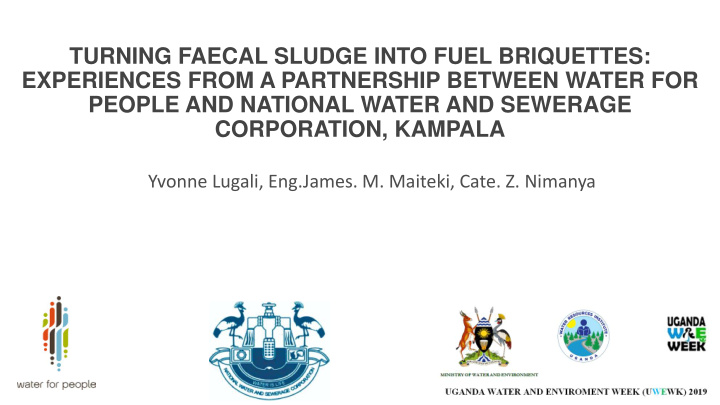



TURNING FAECAL SLUDGE INTO FUEL BRIQUETTES: EXPERIENCES FROM A PARTNERSHIP BETWEEN WATER FOR PEOPLE AND NATIONAL WATER AND SEWERAGE CORPORATION, KAMPALA Yvonne Lugali, Eng.James. M. Maiteki, Cate. Z. Nimanya
• For many years in Africa, FS has remained regarded as a hazardous material, given little attention about energy recovery The from the bio solids Challenge • The most common reuse option has concentrated on direct application of bio solids onto garden- risk of pathogens especially for vegetables eaten raw • One product of FS that is most likely to be free of pathogens is the briquettes. The pathogens are killed during the carbonization or pyrolysis process that requires high temperatures • FS briquettes can be used to replace the wooden charcoal briquettes hence reducing pressure onto the forests in search for charcoal • FS products are normally challenged by community attitudes due to various beliefs and taboos around faeces handling • The process of carbonization completely changes the physical appearances of FS to char which is like that from other biomass.
Why Fecal Sludge Briquettes? 35 Fecal 70kg of 70,000 70,000 70,000 Bag of Sludge stick Ugx Charcoal Ugx Honeycomb Ugx briquettes Briquettes Single burner 1.5 hours 210 hours of lighting for 48 burning time burning time hours per 1kg The briquettes are 4.4 times more cost effective than the normal charcoal
Current Research Results so far • Tested two types of sludge; Bottom Settled and Top Scum • Top scum briquettes overall perform better than bottom sludge briquettes (less sand) • Tested different combinations with varying amounts of FS and charcoal • Organic emissions such as PCBs, Furans and Dioxins dust; 100%FS, 80%FS, 60%FS, were at non-detectable levels 50%FS, 40%FS • SO2,SO3 levels detected at below 5% and this reduced • Partnered with CAPIDA/SEACO to with reduction in FS produce test briquettes • NO2 levels at below 1% reducing with decreasing FS • Carried out tests at CREEC (fuel content properties), Central Government Lab • P2O5 levels at below 10% reducing with decreasing FS (Emissions), Microbiology lab at Content COVAB-Makerere University (Pathogenic occurrence) and our own • Safety: Briquettes tested negative for Faecal Coliforms, mini lab (MC, Ash Content, burning E.Coli and Ascaris (carbonization process at properties and boiling tests) temperatures of above 100 degrees)
Average Energy Output against Percentage of Faecal Sludge (Top Scum) in Briquettes and Wood Comparison of Wood Charcoal and FS (Top Scum) Charcoal Briquettes 35,000 Average Energy Output (kJ/kg) 90% 30,000 80% 25,000 70% 20,000 60% 50% 15,000 40% 10,000 30% 5,000 20% - 10% 100% 80% 60% 50% 40% Wood 0% Charcoal 100% 80% 60% 50% 40% Wood Percentage of Faecal Sludge Char and Wood Charcoal Charcoal Ash Content Fixed Carbon Volatile Matter Time to Boil 5 litres (cold start) 250 200 Minutes 150 100 50 0 100% 80% 60% 50% 40% Wood Charcoal Percentage of FS in Briquettes and Wood Charcoal
Overview of Current Operation • Sludge drying & storage • Carbonization • Briquette production
Current Operations at Lubigi Wastewater Treatment Plant Carbonization and future production site Greenhouse sludge drying & storage Water For People currently operating sludge drying/storage and carbonization facilities at National Water & Sewerage Corporation (NWSC) Lubigi Wastewater Plant. Future plans envision expanded operation with consolidated briquette production facility at the plant.
Sludge Storage & Drying at Lubigi Greenhouse Water For People converted one of NWSC sludge drying beds into covered/enclosed facility (known as the greenhouse) for effective drying and storage of sludge used for carbonization and briquette production
Construction of Carbonization Unit at Lubigi Site
Commissioning of Carbonization Unit Commissioning of the newly constructed carbonization unit is ongoing, with testing to determine procedures and loading rates for optimum operation.
Nyanama Briquette Production Site Water For People has been piloting the production of fecal sludge briquettes at a small demonstration facility in Kampala. The facility includes a receiving/storage area for sludge and charcoal dust, a single-drum carbonization unit, briquette extruding machines, and a storage/drying area for finished briquettes.
Extruders at Nyanama The pilot facility includes locally fabricated briquette extruding machines for both stick and honey briquettes
Briquette Drying at Nyanama Manufactured briquettes are stored and dried prior to packaging and sales. Stick and honeycomb briquettes have have been on an informal basis to a variety of customers to test potential markets.
Packaging at Nyanama for Informal Sales Stick briquettes, packaged in 5 kg sacks have become popular for domestic cooking use. Following a recently completed market assessment, Water For People intends to focus its sales of this product on supermarkets and chicken farmers
Lessons Learnt • Production: Infrastructure, Raw materials, Machinery, Labour, Carbonization, Drying • Safety and Health • Product Quality and features • Product Perceptions
Recommendations • Based on WRP market assessment, focus on two market segments: • Chicken farmers • Supermarkets catering to middle class consumers • New legal entity required before expanding beyond current informal sales • Consolidate production at one facility – Lubigi • Need to establish reliable quality & delivery performance • Briquette Design Optimization (Replace charcoal input) • Increase Production to 5 tonnes/week • Training RRR businesses on incorporation of FS in Briquette Production (GIZ)
Recommend
More recommend